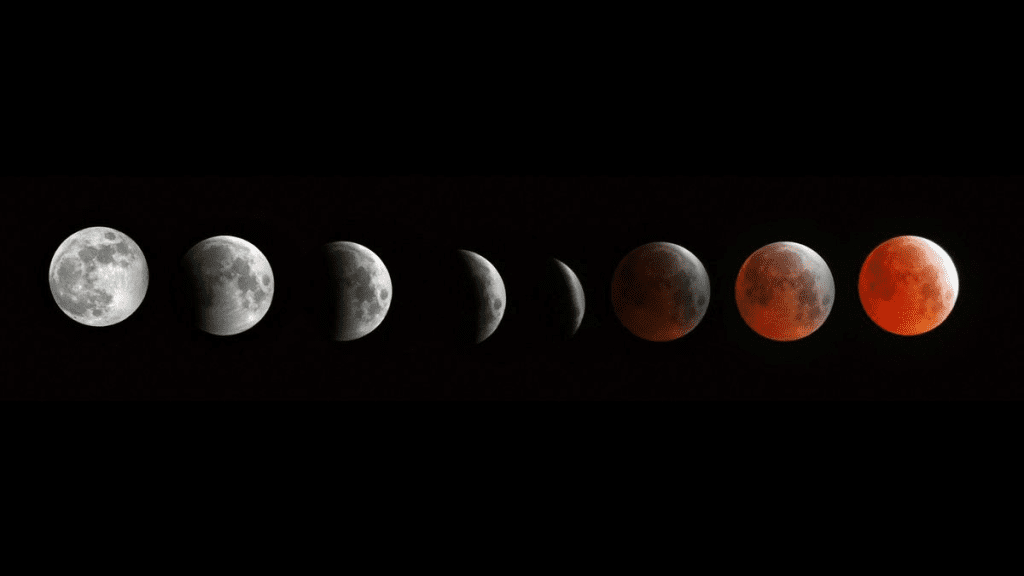Skywatchers, get ready! On the night of March 14-15, 2025, a total lunar eclipse will grace the skies, offering a breathtaking celestial spectacle. For approximately 65 minutes, the Moon will transition from its usual bright white glow to a dramatic deep red or brown hue, creating a mesmerizing sight known as the Blood Moon.
If you’re fascinated by astronomy or simply love witnessing nature’s wonders, this is an event you won’t want to miss. Whether you’re planning to observe it with the naked eye, through a telescope, or capture stunning photographs, this guide will provide all the essential details you need.
What Is a Total Lunar Eclipse?

A total lunar eclipse occurs when the Earth comes directly between the Sun and the Moon, casting a shadow that completely covers the Moon. Unlike a solar eclipse, which requires protective eyewear, a lunar eclipse is perfectly safe to view with the naked eye.
During this event, the Earth’s atmosphere filters sunlight, allowing only longer-wavelength red and orange light to reach the Moon. This is what gives the Moon its eerie red or brown appearance, often referred to as a Blood Moon.
When and Where Can You See It?
The total lunar eclipse will be visible from various parts of the world, but some regions will experience a better view than others. Here’s what you need to know:
- Best viewing locations: North America, South America, parts of Europe, and western Africa will get the best views of the full eclipse.
- Partial visibility: Some areas in Asia and eastern Africa will see only a partial eclipse.
- Total eclipse duration: Approximately 65 minutes of complete totality.
- Eclipse phases: The entire event, from the penumbral phase to the total eclipse and back, will last about three hours.
Video : Total Lunar Eclipse 2025: Will the Stunning Blood Moon Grace Your Skies?
If you’re in an area where visibility is limited due to weather conditions or location, don’t worry! Many astronomy organizations and space agencies will offer live-streams of the event.
What Causes the Blood Moon Effect?
One of the most fascinating aspects of a total lunar eclipse is the Blood Moon phenomenon. But why does the Moon turn red instead of disappearing completely?
This happens due to a process called Rayleigh scattering, the same mechanism responsible for red sunsets and sunrises. When the Earth blocks direct sunlight from reaching the Moon, some of the Sun’s light bends through the Earth’s atmosphere. The shorter wavelengths (blue and violet) scatter, while the longer red and orange wavelengths pass through and illuminate the Moon.
Depending on atmospheric conditions, the Moon can appear in shades ranging from deep red to copper or brown. If there are dust or volcanic particles in the atmosphere, the eclipse could take on an even darker hue.
How to Watch the Total Lunar Eclipse
Viewing a total lunar eclipse is easy and requires no special equipment. However, for the best experience, consider these tips:
- Find a dark location: The farther you are from city lights, the clearer your view will be.
- Check the weather: Cloudy skies can block your view, so make sure to check local forecasts.
- Use binoculars or a telescope: While the eclipse is visible to the naked eye, magnification enhances details like craters and surface textures.
- Capture the moment: If you love photography, use a DSLR camera with a tripod to get sharp images of the Moon’s color changes.
- Bring friends and family: Viewing an eclipse is a magical experience—share it with others!

Why This Lunar Eclipse Is Special
Not all lunar eclipses are created equal. Some are penumbral (where the Moon only passes through Earth’s outer shadow), while others are partial (where only part of the Moon is covered).
However, this event on March 14-15, 2025, is a total lunar eclipse, meaning the Moon will be completely engulfed by Earth’s shadow, creating an intense and dramatic visual effect.
Additionally, this eclipse comes at a time when interest in space and astronomy is at an all-time high, with upcoming missions to the Moon and Mars capturing global attention.
The Cultural and Historical Significance of Lunar Eclipses
Throughout history, lunar eclipses have been seen as mystical and sometimes ominous events. In ancient civilizations:
- The Incas believed a lunar eclipse occurred when a jaguar attacked the Moon.
- The Chinese thought a giant celestial dragon was devouring the Moon and would make loud noises to scare it away.
- Many Native American tribes viewed the event as a sign of change or transformation.
Today, lunar eclipses are understood scientifically, but they still inspire a sense of wonder and curiosity.
Video : Total Lunar Eclipse Blood Moon 14 March 2025 Your Horoscope with Gregory Scott
The Next Total Lunar Eclipses After March 2025
If you miss this one, don’t worry—there are more lunar eclipses coming in the future. The next total lunar eclipses will occur on:
- March 3, 2026
- December 31, 2028
- December 20, 2029
However, the March 2025 eclipse will be one of the longest and most visible in recent years, making it a must-watch event.
Final Thoughts: Don’t Miss This Celestial Event!
The March 14-15, 2025, total lunar eclipse is a rare and breathtaking natural event that reminds us of the beauty of our universe. Whether you’re an astronomy enthusiast or just someone who enjoys witnessing celestial wonders, this is an opportunity you won’t want to miss.
Mark your calendars, find a good viewing spot, and prepare to watch the Moon turn a stunning shade of red as it aligns perfectly with the Earth and Sun.
Are you excited for the eclipse? Share your thoughts in the comments and let us know where you’ll be watching from! Also, don’t forget to share this article with fellow space lovers so they can witness this incredible event, too.
Fact: Never lose her if she has this trait
Moles have long been associated with personality traits, destiny, and fortune. While some people see them as simple skin features, others believe they hold deeper meanings. One of the rarest and most fascinating mole positions is in the middle of a woman’s chest. This placement is linked to intelligence, capability, and success in both career and personal life. If you find a woman with this unique trait, consider yourself lucky—she possesses qualities that make her truly exceptional.

A Mole in the Middle of the Chest: A Symbol of Talent and Success
A mole in the center of a woman’s chest is more than just a mark—it’s a symbol of brilliance. Women with this rare feature are known for their intelligence, resourcefulness, and leadership skills. They approach life with calm determination, a trait that often stems from a disciplined upbringing.
These women are naturally gifted in business and have a keen ability to make wise financial decisions. Their sharp minds help them navigate challenges with ease, making them successful entrepreneurs or professionals. No matter how difficult the path, they persevere and ultimately achieve financial stability and a comfortable lifestyle.
A Strong and Ambitious Personality
Women with this mole placement are not easily swayed by emotions. They are practical, strategic thinkers who understand the importance of wealth and success. Their ambitions drive them to push beyond limits, ensuring they never settle for mediocrity.
However, their high standards can sometimes make them appear distant or overly focused on their goals. They seek partners who match their intellect and ambition, which means their love life might take a while to fall into place. But when they do find the right person, they build strong, lasting relationships.
What Do Moles on a Woman’s Chest Reveal About Her Destiny?
The location of a mole on a woman’s chest can reveal important insights into her personality, wealth, and relationships. Let’s break down different chest mole placements and what they signify.
Mole on the Left Chest: A Sign of Wealth and Good Fortune
A mole on the left breast is considered an extremely lucky sign. Women with this mark are believed to be destined for wealth and success. They have a natural ability to attract money and opportunities, leading to a smooth and prosperous life.
These women also have strong, stable relationships. They often marry successful men who provide them with love and security. Their homes are filled with warmth and happiness, making them ideal partners for long-term relationships.
Mole on the Right Chest: A Life of Happiness and Stability
If a woman has a mole on her right breast, she is likely to lead a peaceful and comfortable life. Unlike those with a mole in the middle of the chest, these women may not be highly ambitious, but they are incredibly lucky.
They rarely struggle with financial difficulties and often enjoy a steady and prosperous career. Though they may experience some challenges in their love life early on, they eventually find a devoted and loving partner. Once married, they live a fulfilling life with a supportive spouse and obedient children.
Mole Under the Breast: A Symbol of Prosperity and Attraction

A mole growing beneath the breast is considered a powerful symbol of financial abundance. Women with this mole placement are naturally attractive and charming, often drawing admiration from men.
Left Side vs. Right Side: The Key Differences
- Left-side mole: Indicates inherited wealth, such as land, properties, or family businesses. These women enjoy financial stability without needing to struggle for it.
- Right-side mole: Symbolizes effortless prosperity. These women attract good fortune without working excessively hard. Their destiny is filled with abundance, and they rarely experience financial hardships.
Additionally, women with moles in this position tend to marry into wealthy families. They are well-loved by their husbands and lead comfortable, luxurious lives.
Mole in the Middle of the Cleavage: A Rare Mark of Power and Determination
A mole positioned in the cleavage is one of the most intriguing placements. Women with this mole are naturally ambitious and driven to succeed. They set high goals for themselves and work tirelessly to achieve them.
The Hidden Power of This Mole
- They are strategic thinkers, capable of making well-calculated decisions.
- They are not easily influenced, as they trust their instincts and intelligence.
- They are high achievers, often reaching great heights in business or leadership roles.
However, their ambition can sometimes isolate them from others. They are so focused on their goals that they may neglect personal relationships. Additionally, because of their high expectations, they take their time choosing a life partner, often delaying marriage until they find the perfect match.
Interestingly, if the mole in the cleavage is red, it is believed to bring extraordinary luck. These women receive guidance from powerful mentors and often build a strong, influential network that helps them succeed.
Conclusion: The Woman with the Rare Chest Mole is a Treasure
If you ever meet a woman with a mole in the middle of her chest, cherish her—she is a rare gem. She possesses intelligence, ambition, and an unstoppable drive for success. Her ability to navigate challenges with grace and determination makes her an extraordinary person.
Moles on the chest hold deep meaning, revealing hidden strengths and unique destinies. Whether on the left, right, or middle, each placement carries a different fortune. But among them all, the mole in the middle stands out as a mark of greatness.
Women with this feature are destined for success and wealth. They are not only powerful in business but also selective in love. While their ambitions may delay romance, they eventually find partners who respect and admire their strength.
So, if she has this trait, never let her go—she is someone truly special.



Leave a Reply